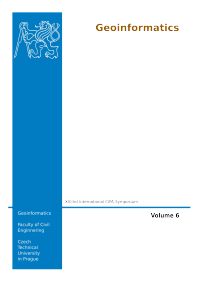A Semiautomatic Large-Scale Detection of Simple Geometric Primitives for Detecting Structural Defects from Range-Based Information
DOI:
https://doi.org/10.14311/gi.6.17Keywords:
architectural surveying, semi-automatic recognition, defects detection, intervention assessment.Abstract
Buildings in Cultural Heritage environments exhibit some common structural defects in elements which can be recognized by their differences with respect to the ideal geometric model. The global approach consists of detecting misalignments between elements corresponding to sections perpendicular to an axis, e.g. The local approach consists of detecting lack of verticality or meaningful differences (facades or internal walls) in curved elements with typical components (apses or vaults, e.g.) appearing in indoor environments. Geometric aspects concern to the basic model which supports successive layers corresponding to materials analysis and mechanical structural behaviour. A common strategy for detecting simple shapes consists of constructing maps of normal which can be extracted by an appropriate sampling of unit normal vectors linked to a points cloud. The most difficult issue concerns to the sampling process. A profusion of decorative details or even the small variations corresponding to small columns which are prolonging the nerves of vaults generate a dispersion of data which can be solved in a manual way by removing notrelevant zones for structural analysis. This method can be appropriate for small churches with a low number of vaults, but it appears as tedious when we are trying to analyse a large cathedral or an urban district. To tackle this problem different strategies for sampling information are designed, where some of them involving geometric aspects have been implemented. We illustrate our approach with several examples concerning to outdoor urban districts and indoor structural elements which display different kinds of pathologies.References
Schnabel, R. and Wahl, R. and Klein, R. Efficient RANSAC for Point-Cloud Shape Detection. Computer Graphics Forum, 26 (2), 214--226, ACM.
Bao-Quan Shi, Jin Liang, Qing Liu. Adaptive simplification of point cloud using k-means clustering. ComputerAided Design 2011. Accepted Manuscript, ISSN 0010-4485, Elsevier.
P.H.S. Torr and C. Davidson, IMPSAC: Synthesis of Importance Sampling and Random Sample Consensus, presented at IEEE Trans. Pattern Anal. Mach. Intell., 2003, pp.354-364.
M. A. Fischler and R. C. Bolles. Random Sample Consensus: A Paradigm for Model Fitting with Applications to Image Analysis and Automated Cartography. Comm. of the ACM 24: 381–395. 1981.
Bao-Quan Shi, Jin Liang, Qing Liu. Adaptive simplification of point cloud using k-means clustering. ComputerAided Design 2011. Accepted Manuscript, Available online 9 April 2011, ISSN 0010-4485, Elsevier.
D. A. Forsyth and J. Ponce. Computer Vision, a modern approach. Prentice Hall. 2003.
R. Hartley and A. Zisserman (2003). Multiple View Geometry in Computer Vision (2nd edition). Cambridge University Press.
J.D. Pérez-Moneo, J. Finat, J.J. Fernández, J. I. San José and J. Martínez. UVACAD: A software platform for 3D architectural surveying. XXI CIPA International Symposium: Anticipating the Future of the Cultural. VOL. XXXVI5/C53 ISNN 1682-1750. Athens 2007.
J. I. San José, J.D. Pérez, J. Finat, J.J. Fernández and J. Martínez. Evaluation of structural damages from 3D Laser Scans. XXI CIPA International Symposium: Anticipating the Future of the Cultural, Athens, 2007
Vosselman, G. and Gorte, B.G.H. and Sithole, G. and Rabbani, T. Recognising structure in laser scanner point clouds. International Archives of Photogrammetry, Remote Sensing and Spatial Information Sciences 46 (8), 33—38, 2004.
Pauly, M. and Gross, M. and Kobbelt, L.P. Efficient simplification of point-sampled surfaces. Visualization, 2002, 163--170, IEEE.
Downloads
Published
Issue
Section
License
- Authors retain copyright and grant the journal right of first publication with the work simultaneously licensed under a Creative Commons Attribution License that allows others to share the work with an acknowledgement of the work's authorship and initial publication in this journal.
- Authors are able to enter into separate, additional contractual arrangements for the non-exclusive distribution of the journal's published version of the work (e.g., post it to an institutional repository or publish it in a book), with an acknowledgement of its initial publication in this journal.
- Authors are permitted and encouraged to post their work online (e.g., in institutional repositories or on their website) prior to and during the submission process, as it can lead to productive exchanges, as well as earlier and greater citation of published work (See The Effect of Open Access).

